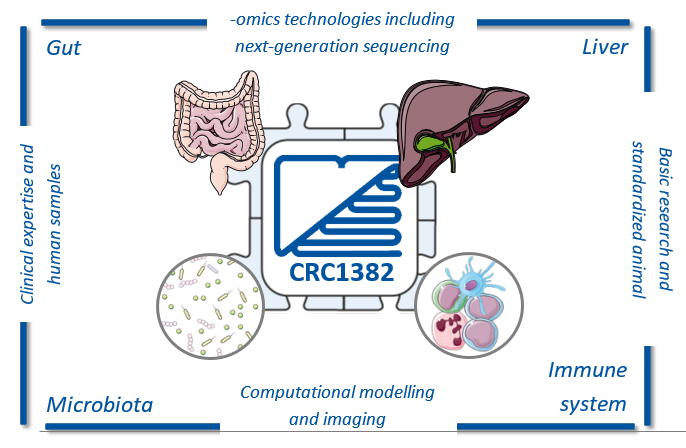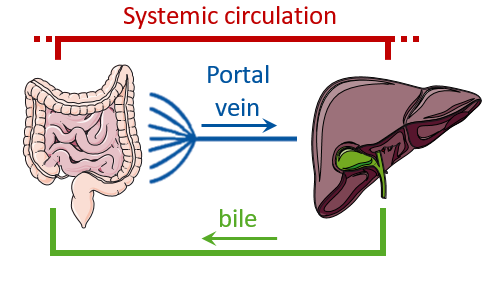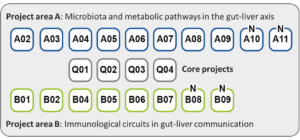CRC 1382 – Gut-liver Axis – Functional circuits and therapeutic targets
Gut and Liver form a functional entity in health and disease.
- Gut and Liver develop from a common cellular ancestor.
- Gut and Liver cooperate in nutrient uptake and metabolism.
- Gut and Liver separate the microbiota-containing gut lumen from the systemic circulation.
- Gut and Liver in concert ensure tolerance to microbiota and dietary antigens.
- Gut and Liver provide immunity to pathogens.
This crosstalk between gut and liver is rarely considered in research and clinical practice!
Research projects in CRC1382 replace the traditional organ-centred view of gut and liver by an integrated approach considering the combined function of gut, liver, their metabolic and immunological capacity and their role in host-microbial interaction.

Anatomical, cellular, and molecular circuits facilitate the cooperation of gut and liver
The portal vein passes venous blood with its cellular and molecular contents from the intestine to the liver.
Conversely, the bile duct transports hepatic products and mediators into the intestinal lumen.
Endocrine mediators, cytokines, bile salts, migrating immune cells and microbiota-derived factors functionally interconnect both organs. Immune cells in gut and liver integrate signals from the environment and from within the gut-liver axis to regulate homeostasis and inflammation in the gut-liver unit.

The functional link between gut and liver manifests in human disease
Historically, the concept of ‘gut-liver axis’ has been put forward to describe the presence of antibodies directed against intestinal microorganisms and food antigens in the circulation of patients with liver cirrhosis, the common end stage of chronic liver diseases.
Today, we know that many diseases show a major association of gut and liver.
Pathophysiological changes in the gut affect the liver and vice versa
Diseases affected by the gut-liver axis include primary sclerosing cholangitis, alcoholic and non-alcoholic liver disease, malignant transformations in gut and liver, inflammatory bowel disease (IBD) and coeliac disease.
Clinical evidence indicates that the gut-liver axis can be therapeutically targeted, for instance by faecal microbiota transplantation, antibiotics, dietary interventions or modulation of the bile salt pool and its signalling. Such therapies are already used in clinical practice. However, at present the molecular and immunological basis for such therapeutic trials is very weak.
“Our mission is to elucidate molecular mediators and functional circuits of the gut-liver axis to mechanistically understand hepatic and intestinal physiology and diseases. We aim to improve modelling of the gut-liver axis as well diagnostics and to define promising therapeutic approaches targeting the gut-liver axis.”
Organization of CRC 1382
CRC 1382 is organized in two main projects areas.
In project area A, ‘Microbiota and metabolic pathways’, we aim at defining the mechanisms of how gut-liver interactions impact metabolism in health and disease. In nine projects we study the interactions between microbiota, microbial and host metabolism and the stroma in order to decipher their contributions to intestinal and hepatic diseases.
In project area B, ‘Immunological circuits’, we focus on immune cell-mediated aspects of the gut-liver axis. Immunological mechanisms are evolutionarily fundamental for proper metabolic functions of the gut-liver axis and control of the microbiota. At the same time, host-microbe interactions need to ensure effective defence mechanisms against pathogens. Thus, an improved understanding of immunological mechanisms within the gut-liver axis is crucial.
Project areas A and B are complemented by two scientific service projects, Q01 (in vivo imaging) and Q02 (functional microbiota analysis). Core project Q03 houses the CRC1382 associated graduate school ‘Gut-Liver Axis’. Administrative core project Q04 is dedicated to central tasks of the CRC.


Project Area A
Microbiota and metabolic pathways,
…defining the impact of gut-liver interactions on liver pathophysiology…
Projects in this area concentrate on interactions between microbiota, microbial and cellular metabolism and the stroma in order
to decipher their contributions to intestinal and hepatic diseases.
A02, A03, A08 and A09 analyze pathomechanisms in gut and liver that are triggered by diet and alcohol in experimental and clinical settings.
A04 explores molecular mediators of the gut-liver axis in portal blood.
A05 and A07 study the contribution of bile salts to gut-liver communication.
A10, a new project initiated in the 2nd funding period, studies the effects of gut mediators on motility and translocation of gut commensal bacteria.
A11, another new project initiated in the 2nd funding period, exploits large scale population based datasets to analyse the impact of dietary factors on liver disease development.
Projects A01 and A06 are not continued in the second funding period.

Project Area B
Immunological circuits
…deciphering immune cell-mediated aspects of the gut-liver axis…
Projects in this area consider homeostasis and malfunctions of the gut-liver axis as the interplay between immune cells, microbiota, metabolism and other environmental factors.
B01 dissects dynamic changes in the gut-liver axis during postnatal development.
B02 studies the link between immune cell migration and hepatic manifestations of intestinal diseases.
B04 focusses on the roles of dendritic cells in homeostasis as well as in patients with chronic liver disease and impaired intestinal barrier functions.
B05 characterizes the consequences of gut-derived molecular signals on the origin and function of hepatic macrophages.
B06 studies the interrelation between hepatic and intestinal IgA producing plasma cells.
B07 explores the capacity of the gut-liver axis in limititing translocation of bacteria and the risk of sepsis in patients with decompensated liver cirrhosis.
B08, a new project initiated in the 2nd funding period, analyzes the influence of gut-derived factors on liver during cancer.
B09, another new project initiated in the 2nd funding period, dissects microbiota-dependent and -independent functions of inflammasome-mediated immunity during Hepatocellular Carcinoma development.
B03 will not be not continued in the second funding period.

Project Area Q
Core projects
…data integration, scientific education and administration…
Q01 offers expertise and support in a wide array of high-end imaging techniques.
Q02 facilitates complex microbial community analyses.
Q03 is home of the CRC1382 associated graduate school ‘Gut-Liver Axis’.
Q04 serves central administrative tasks of the consortium.
